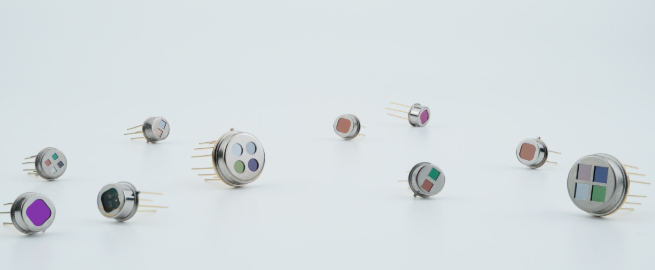
Lithium tantalate (LiTaO₃, LTO) and lead zirconate titanate (PZT) are two of the most commonly used pyroelectric materials. They each have their own advantages and disadvantages in the field of pyroelectric sensors, and their application scenarios also differ.
Comparison of core parameter differences
Parameters | Lithium Tantalate (LiTaO₃) | Lead zirconate titanate (PZT) |
Pyroelectric coefficient | Medium (approx. 0.2-0.4 µC/(cm²·K)) | High (approx. 3.8 µC/(cm²·K)) |
Dielectric constant | Low (approx. 47) | High (approx. 180-1200, depending on formulation) |
Figure of merit (FOM) | High | Medium |
Detectability (D*) | Typically higher | Relatively low |
Curie temperature | Very high (~610℃) | Low (approx. 200-400℃, depending on formulation) |
Temperature stability | Excellent, stable performance over a wide temperature range | General, performance varies significantly with temperature |
Chemical stabili ty | Excellent, moisture resistant, not prone to aging | Good, but may be affected by deliquescence (requires encapsulation) |
Mechanical strength | High, robust and durable | Brittle and easily broken |
Material composition | Lead-free, environmentally friendly | Contains lead, raises environmental and RoHS compliance issues |
Cost | High | Low, mature manufacturing process, significant cost advantage |
Key Parameter Analysis
1. Pyroelectric Coefficient vs. Dielectric Constant: Figure of Merit is Key
Pyroelectric Coefficient: Measures a material's ability to convert temperature changes into electrical charge. PZT has a natural advantage in this regard, with a coefficient much higher than LTO.
Dielectric Constant: Affects the capacitance of the sensor. A high dielectric constant leads to a larger capacitance, resulting in greater Johnson noise in the circuit and affecting high-frequency response.
Figure of Merit: This is the core indicator for evaluating the overall electrical performance of pyroelectric materials. Commonly used figure of merit include:
Current Response Figure of Merit Fi = p / c' (p: pyroelectric coefficient, c': volumetric specific heat capacity). A high Fi means a large current generated per unit temperature change.
Voltage Response Figure of Merit Fv = p / (c' * ε₀εr). A high Fv means a large voltage signal generated per unit temperature change.
Conclusion: Although PZT has a high p value, its εr is also very high, resulting in a lower Fv value compared to LTO. LTO achieves a very high Fv (Function V) due to its moderate p-value and extremely low εr, making it superior in high-impedance, high-voltage-response applications, with typically higher detectivity (D*).
2. Temperature Stability and Curie Temperature
LTO has a high Curie temperature of 610°C, far exceeding typical operating temperatures. This means its performance remains virtually unchanged over a wide industrial or automotive temperature range from -40°C to +85°C and even wider, exhibiting exceptional stability and reliability.
PZT has a lower Curie temperature, and its pyroelectric properties drift significantly with changes in ambient temperature. Temperature compensation circuitry may be required in demanding applications.
3. Reliability and Environmental Friendliness
LTO is chemically very stable, non-hygroscopic, and resistant to "aging" (performance degradation over time). It also possesses good mechanical strength, is lead-free, and complies with increasingly stringent environmental regulations (such as RoHS).
While PZT offers excellent performance, its lead content is its biggest disadvantage. Its application in certain fields (such as automotive electronics and consumer electronics) is limited or requires exemptions.
Application Scenarios
Typical Applications of Lithium Tantalate (LTO) Sensors

Due to their high detectivity, high stability, and lead-free characteristics, LTO is commonly used in fields with stringent performance and environmental requirements.
1. High-Performance Infrared Thermometry and Imaging:
Non-Contact Pyrometers: Used for high-precision temperature measurement in industrial processes such as steel, glass, and semiconductor manufacturing. Wide temperature range and stability are crucial.
Thermal Imagers: Especially for thermopile-type infrared cameras with single units or a small number of pixels, LTO is one of the preferred materials.
2. Gas Analysis:
NDIR (Non-Dispersive Infrared) Gas Sensors: Used for detecting CO₂, methane, Freon, etc. The high signal-to-noise ratio and stability of LTO sensors result in lower detection limits and higher accuracy, making them commonly used in environmental monitoring, industrial safety, and high-end HVAC systems.
3. Flame Detection:
Industrial flame detectors require high reliability and rapid response to specific infrared bands; LTO is an ideal choice.
4. Aerospace:
These fields have extremely high requirements for the device's adaptability to extreme environments and long-term reliability, with cost being a secondary consideration.
Typical Applications of PZT Pyroelectric Sensors

Thanks to its high sensitivity and low cost, PZT dominates the consumer and industrial sectors with its widespread application.
1. Human Motion Sensing:
This is the largest application of PZT. Applications include security alarms, automatic lights, automatic doors, and smart home sensors. PZT chips are low-cost and well-suited for detecting moving heat sources, with less stringent requirements for absolute accuracy and temperature stability.
2. Low-End Infrared Thermography:
Consumer-grade medical devices such as ear thermometers and forehead thermometers. PZT's high output is sufficient to meet accuracy requirements of approximately ±0.1°C, and the cost is controllable.
3. Energy Harvesting:
In experiments utilizing waste heat for power generation, PZT's high pyroelectric coefficient facilitates the generation of more charge under limited temperature differences.
4. Consumer Electronics and IoT Devices:
PZT is the preferred choice for any cost-sensitive application requiring the detection of temperature changes or infrared signals.
Summarize
Features | Lithium Tantalate (LiTaO₃) | Lead zirconate titanate (PZT) |
Positioning | "High-performance, high-reliability" solution | "High cost-performance and economical solution" |
Advantages | High detectivity, high stability, wide temperature range, lead-free and environmentally friendly | High sensitivity, low cost, mature technology |
Disadvantages | Higher cost | Poor temperature stability, lead content, high dielectric loss |
Selection Criteria | When your application has stringent requirements for accuracy, stability, signal-to-noise ratio, and environmental friendliness, and you have a sufficient budget. | Suitable for applications requiring basic detection functions and extremely cost-sensitive applications. |
Share